Executive Summary Examples for Business Plans, Project Plans, and Research Projects
By Kate Eby | February 8, 2024
- Share on Facebook
- Share on LinkedIn
Link copied
Executive summaries allow decision-makers to quickly grasp the key points of important documents and make decisions. We’ve collected a variety of executive summary examples and templates that you can use as models for your executive summaries.
Included in this article, you’ll find a business plan executive summary example , a project proposal executive summary example , a research report executive summary example , and more. Plus, learn how to fix common executive summary mistakes .

What Are the Main Components of an Executive Summary?
An executive summary is a concise overview of a larger document, report, or proposal. It gives high-level executives or decision-makers a quick understanding of the main points of a longer document without requiring them to read the whole text.
These are the components you might include in an executive summary:
- Problem Statement: Clearly state the problem or challenge the company, product, or project addresses.
- Key Proposition: Outline the proposed solution or key value proposition.
- Market Analysis: Summarize findings about the market, customer needs, or competition.
- Key Features and Benefits: Highlight the main features or benefits of the proposed solution or strategy.
- Financial Summary: Provide a snapshot of financial aspects, such as cost, revenue projections, or return on investment (ROI).
- Next Steps: Briefly describe the next steps or strategy for implementation.
Simple Executive Summary Example
The following simple executive summary presents a concise statement of key findings and links them directly to a strategic recommendation. It provides a clear snapshot of the situation and the proposed action, which is essential for an executive summary.
Problem Statement
Many small businesses struggle with inefficient inventory management, leading to lost sales and increased operational costs.
Key Proposition
Our company proposes an AI-driven inventory management system that automates tracking and forecasting, tailored for small businesses.
Market Analysis
Research shows a 40 percent increase in demand for automated inventory solutions in the small business sector, with a significant gap in affordable, user-friendly options.
Key Features and Benefits
The system offers real-time inventory tracking, predictive restocking alerts, and an intuitive interface, reducing inventory errors by an estimated 50 percent.
Financial Summary
Our projected development cost is five hundred thousand dollars with a break-even point in 18 months. The expected ROI is 200 percent in three years, tapping into a market with a potential revenue of five million dollars annually.
Development will commence in Q1 2024, with a pilot launch in Q3. Full market release is scheduled for Q1 2025, followed by targeted marketing campaigns and customer feedback integration for further enhancements.
Executive Summary Template
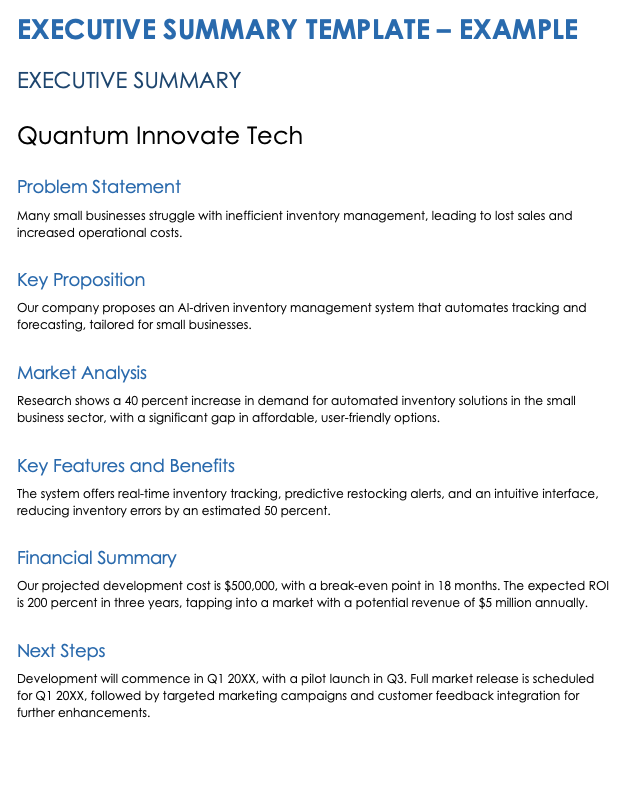
Download a Blank Executive Summary Template for
Microsoft Word | Google Docs
Download an Example Executive Summary Template for
Available in blank and example versions, this executive summary template guides you in succinctly presenting key information about your business plan or project to stakeholders. Simply fill in each section with relevant details to create a concise overview that highlights problems, solutions, market potential, product features, financials, and next steps.
Business Plan Executive Summary Example
Review the following example for a business plan executive summary of an eco-friendly transportation company. This example provides a clear, brief overview that is essential when you want to engage stakeholders and set the stage for more detailed discussions.
In urban areas, the lack of convenient, eco-friendly transportation options leads to increased traffic congestion and pollution.
GreenGo Mobility Solutions proposes a network of e-bike sharing stations, offering an affordable, sustainable, and flexible transportation alternative.
There is a growing trend toward eco-friendly transport in cities, with a 60 percent increase in e-bike usage. Surveys show high interest among urban commuters for more accessible e-bike options.
Key Features and Benefits
Our e-bikes are equipped with GPS tracking and easy-to-use interfaces. The bikes are designed for urban environments, offering a convenient and environmentally friendly commuting option.
The project requires an initial investment of two million dollars, with projected annual revenue of five million dollars by the third year. We anticipate a break-even point within two years, based on subscription and pay-per-use models.
Marketing Plan Executive Summary Example
In the following example, an executive summary outlines a marketing initiative within a company, detailing both the challenge and the strategic response. It provides a clear overview of the marketing plan’s objectives, actions, and expected outcomes.
We have seen a decline in new user adoption of our company's flagship software product over the past year.
Initiate a Revitalize and Engage campaign, focusing on updating the product’s user interface and enhancing customer engagement through social media and community building.
Competitor analysis and customer feedback indicate a need for more intuitive design and stronger community presence to attract and retain users.
The campaign will introduce a sleek, user-friendly interface and a robust online community platform, aiming to increase user engagement and satisfaction.
The campaign requires a budget of five hundred thousand dollars, with an expected increase in user adoption rates by 20 percent within the first year post-implementation.
Begin a UI redesign in Q2 2024, launch a social media engagement strategy in Q3, and roll out the updated product with community features in Q4.
Project Proposal Executive Summary Example
The example executive summary below demonstrates a well-structured project proposal that succinctly identifies a specific challenge and proposes an actionable solution. It provides a comprehensive snapshot of the project, including its rationale, expected benefits, financial implications, and implementation timeline.
Our current customer relationship management (CRM) system is outdated, leading to inefficiencies in sales tracking and client management.
We propose the development and implementation of a new, custom-built CRM system to streamline sales processes and enhance customer engagement.
Internal analysis indicates a 35 percent increase in process efficiency with a modern CRM system, while competitor benchmarking shows significant advantages in customer retention.
The new CRM will offer real-time sales tracking, automated client communication tools, and advanced analytics features, improving sales efficiency and customer satisfaction.
The estimated project cost is two million dollars, with a projected increase in sales efficiency by 50 percent and customer retention by 20 percent within two years.
Initiate the project in Q2 2024, with phase-wise implementation and employee training, aiming for full deployment by the end of Q4 2024.
Startup Executive Summary Example
Startups need to communicate their vision to potential investors and key stakeholders. In this example, an executive summary helps convey the startup’s vision with a concise summary of the business opportunity, unique selling proposition, market potential, and action plan.
There is a growing demand for sustainable and eco-friendly home cleaning products, but the market lacks options that are both effective and affordable.
EcoClean Innovations is a startup offering a line of environmentally friendly, biodegradable cleaning products made from natural ingredients, catering to eco-conscious consumers.
Market trends show a 50 percent increase in consumer preference for green homecare products, with a significant gap in cost-effective options.
Our products are non-toxic and competitively priced, and they have a minimal environmental footprint, addressing the need for effective and sustainable cleaning solutions.
We require an initial investment of one million dollars, projecting a 30 percent market penetration in the eco-friendly segment within the first two years.
Launch with an initial range of products by Q3 2024, followed by marketing campaigns targeting eco-conscious communities and online marketplaces.
Real Estate Development Executive Summary Example
In the following executive summary example for a construction project, the author outlines their vision for the Greenway Residential Complex. This summary captures the essence of the construction project proposal, presenting key information in a concise and structured format.
The growing urban population in Metro City has led to a shortage of affordable, eco-friendly housing options, resulting in increased living costs and environmental concerns. Key Proposition
Our project proposes the development of the Greenway Residential Complex, a sustainable and affordable housing solution. Utilizing innovative construction methods and eco-friendly materials, the complex aims to provide a balanced urban living experience that is both cost-effective and environmentally responsible.
Research indicates a high demand for eco-conscious housing in Metro City, with a market gap in affordable segments. Surveys show that young families and professionals are actively seeking sustainable living options that align with their environmental values and budget constraints.
- Sustainable design incorporating solar panels, rainwater harvesting, and green spaces
- Affordable pricing, targeting middle-income families and young professionals
- Proximity to public transportation and city centers, reducing commute times and the carbon footprint
- High-quality, energy-efficient building materials, ensuring lower utility costs and a smaller environmental impact
- Estimated project cost: Fifty million dollars
- Anticipated revenue from sales: Seventy million dollars, with a projected ROI of 40 percent over five years
- Funding secured from green building grants and private investors
- Finalize construction permits and approvals by Q2 2024.
- Begin construction in Q3 2024, with a projected completion date in Q4 2026.
- Launch a marketing campaign targeting eco-conscious families and professionals. Tip: In this example, notice how helpful it is to use bullet points to convey certain information. Using bulleted lists is a great way to organize and present information in an executive summary.
Construction Project Executive Summary Example
Construction projects have many moving parts, which means executive summaries need to capture a lot of information in a small space. Consider a construction-specific executive summary template to ensure that stakeholders are keyed into the most vital project information.
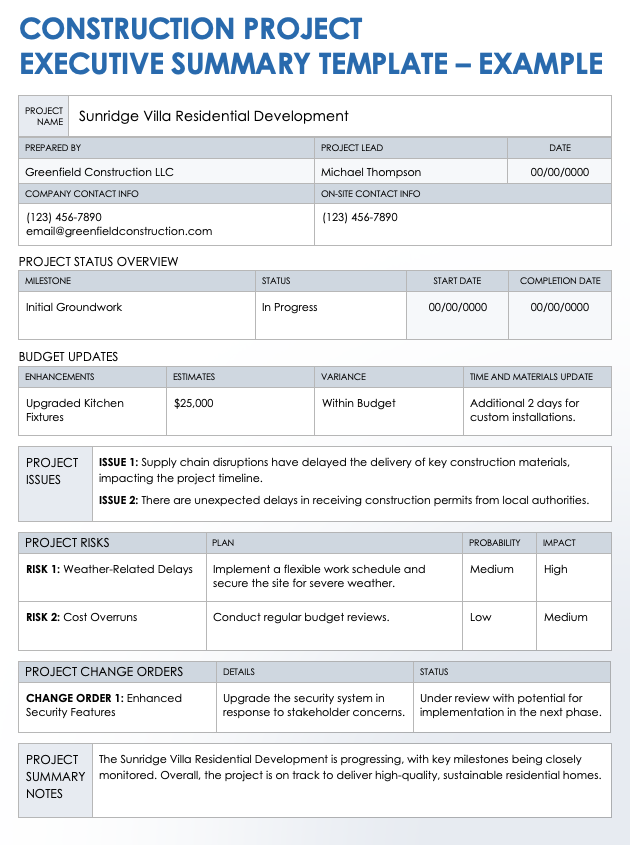
Download a Blank Construction Project Executive Summary Template for
Microsoft Word | Adobe PDF | Google Docs
Download an Example Construction Project Executive Summary Template for
Microsoft Word | Adobe PDF | Google Docs
This construction project executive summary template allows users to give a high-level overview of the key aspects of a project, such as status, risks, issues, and changes. Available in both blank and sample versions, this editable template condenses complex project information into an easily digestible format. To use it, simply fill in each section with relevant, concise information about the current state and progress of your construction project, ensuring it remains updated and reflective of any changes or developments.
Renewable Energy Initiative Executive Summary Example
A renewable energy initiative executive summary should highlight the project’s objectives, strategies, and potential impact, as well as its contribution to environmental sustainability. In the following example, the summary articulates the project’s vision and its alignment with global environmental goals.
The urgent need to address environmental challenges and the increasing global demand for energy underscore the importance of transitioning to renewable energy sources. The reliance on traditional fossil fuels is unsustainable and contributes significantly to climate change.
The SunWind Project is a pioneering initiative combining solar and wind power to create a robust and sustainable energy solution. This project aims to leverage the strengths of both solar and wind energy, ensuring a continuous and reliable power supply while significantly reducing carbon emissions.
The renewable energy sector is experiencing rapid growth, fueled by global environmental policies and a rising consumer preference for sustainable energy. This shift presents an opportunity for the SunWind Project.
The project is unique in its integration of solar panels and wind turbines, ensuring consistent energy production under varying weather conditions. This scalable approach is designed to adapt to increasing energy demands. By significantly reducing the carbon footprint, the project supports global environmental sustainability goals and has the potential to power thousands of homes and businesses.
The SunWind Project has an estimated cost of two hundred million dollars, with projected revenues from energy sales anticipated to be around three hundred million dollars over the next 10 years. This represents a potential ROI of 50 percent. The project is poised to benefit from green energy grants, government subsidies, and private investments.
Immediate steps include securing the necessary environmental permits and clearances. The construction phase, slated to begin in the second quarter of 2024, will focus on installing solar panels and wind turbines, with a goal to commence energy production by the end of 2025.
One-Paragraph Healthcare Executive Summary Example
An executive summary of a healthcare initiative needs to do the following: concisely identify a pressing healthcare issue, present a tailored solution with its benefits, summarize market needs and competition, and outline the financial viability and next steps.
In the following example, notice how an executive summary can capture all key elements in a single paragraph:
The HealthFirst Community Wellness Initiative addresses the critical problem of rising chronic illness rates in urban areas, focusing on diabetes and heart disease. Our comprehensive solution involves launching community health centers that provide preventive care, lifestyle education, and regular health screenings, as well as cater to the specific needs of urban populations. Market analysis indicates a significant demand for accessible healthcare services in these areas, with a lack of preventive and educational resources being a key gap. The initiative’s main features include state-of-the-art diagnostic tools, personalized health plans, and collaboration with local fitness and nutrition experts, offering benefits such as improved community health outcomes and reduced healthcare costs. Financially, the project is expected to be sustainable, with a mix of funding from public health grants and private partnerships. We are projecting a positive ROI within three years due to reduced hospital admissions. The next steps involve securing funding, establishing partnerships with local health professionals and organizations, and launching a pilot center in the downtown district, with a plan to expand to five more urban areas within two years.
Nonprofit Executive Summary Example
An executive summary for a nonprofit organization should communicate the essence of a project or initiative to donors and volunteers. It should concisely outline the organization’s mission, goals, and key solutions while also detailing strategies, actions, and their impact.
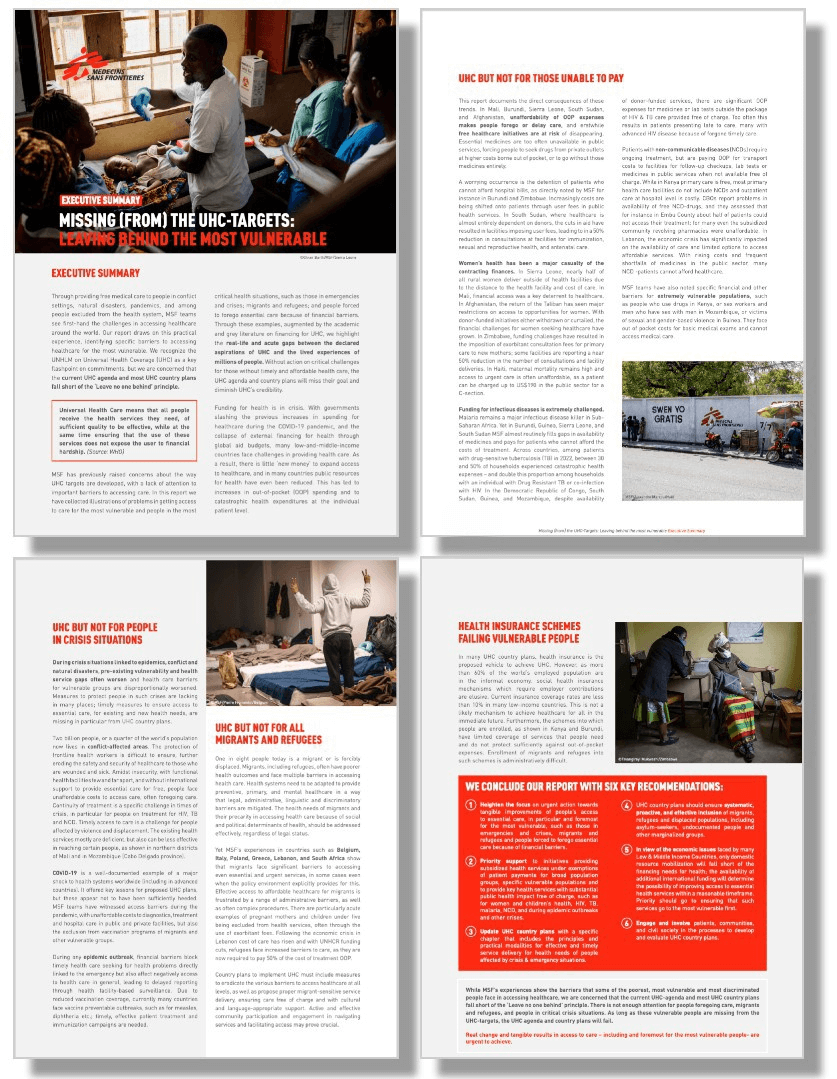
This executive summary example from Doctors Without Borders emphasizes the inadequacy of current Universal Health Coverage (UHC) agendas in meeting the needs of vulnerable populations. It then proposes six key recommendations to address these shortcomings.
This executive summary succinctly identifies the core issue — inequitable access to healthcare — and clearly outlines actionable recommendations. This document helps facilitate advocacy and policy change, which are central to this organization’s goals.
Research Report Executive Summary Example
An executive summary in a research report concisely presents the key findings, conclusions, and recommendations derived from a research project. It covers elements such as the project topic, background, research methods, and critical insights, tailored for quick understanding and decision-making.
In this real-world exampl e from the ASPCA , the executive summary details a study showing that veterinary hospitals’ proactive discussions about pet health insurance positively impacted hospital revenue and increased patient visits.
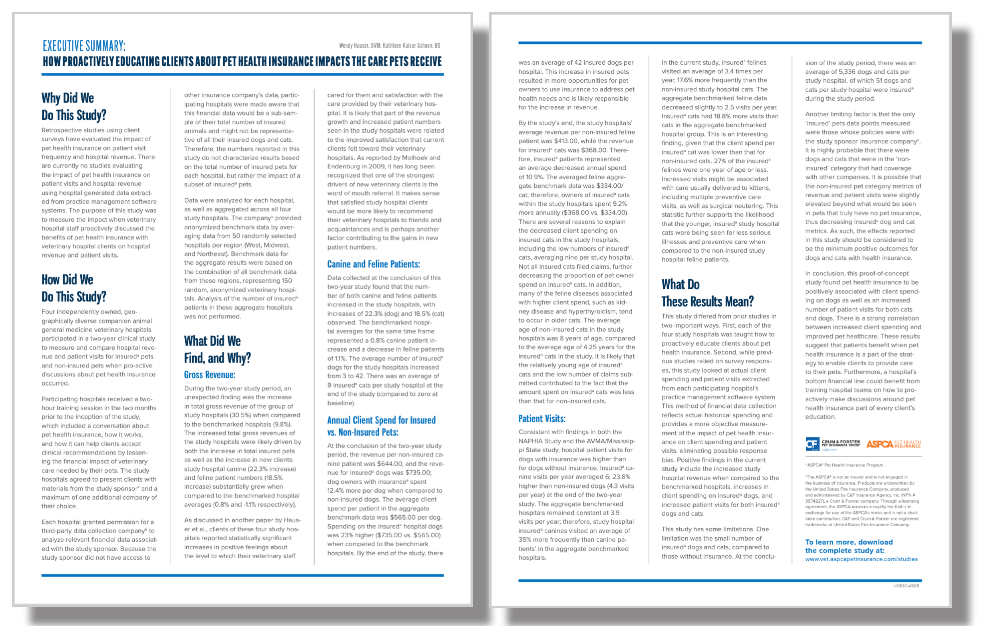
Notice how this summary concisely outlines the study’s purpose, methodology, and significant findings, providing a clear overview for readers. In addition, it highlights the study’s relevance and implications for veterinary practices, emphasizing the practical benefits of educating clients about pet health insurance.
Research Report Executive Summary Template
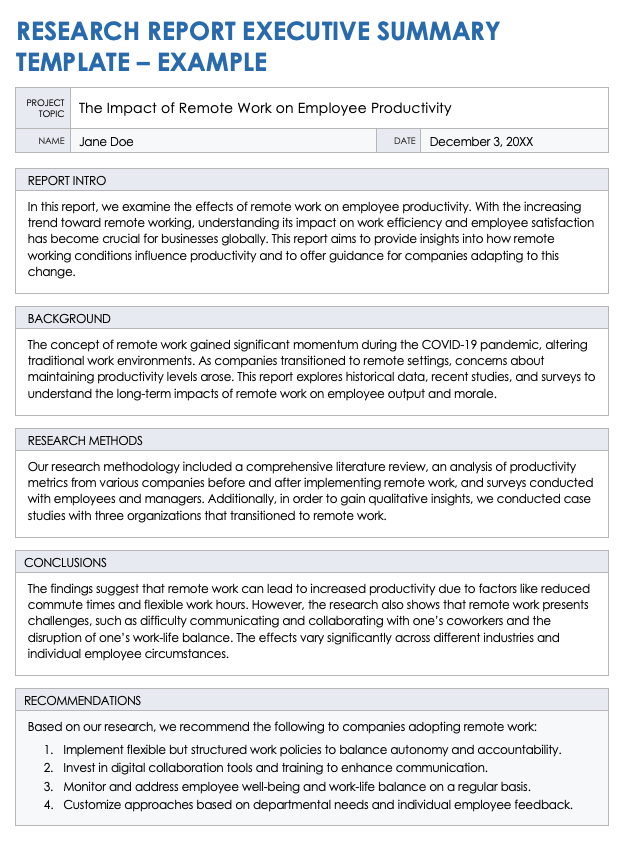
Download a Blank Research Report Executive Summary Template for
Microsoft Word | Adobe PDF | Google Docs Download an Example Research Report Executive Summary Template for
To create your own research report executive summary, download this customizable template. Available in blank and example versions and three printable formats, this template serves as a structured guide to organize and present the key components of a research report. Simply fill in each section with specific details about your research, including the project topic, background information, methods used, conclusions, and recommendations.
Research Project Proposal Executive Summary Example
An executive summary for a research project focuses mainly on the research question, methods, and expected outcomes. These summaries often point out how important the research could be and what impact it might have on the field.
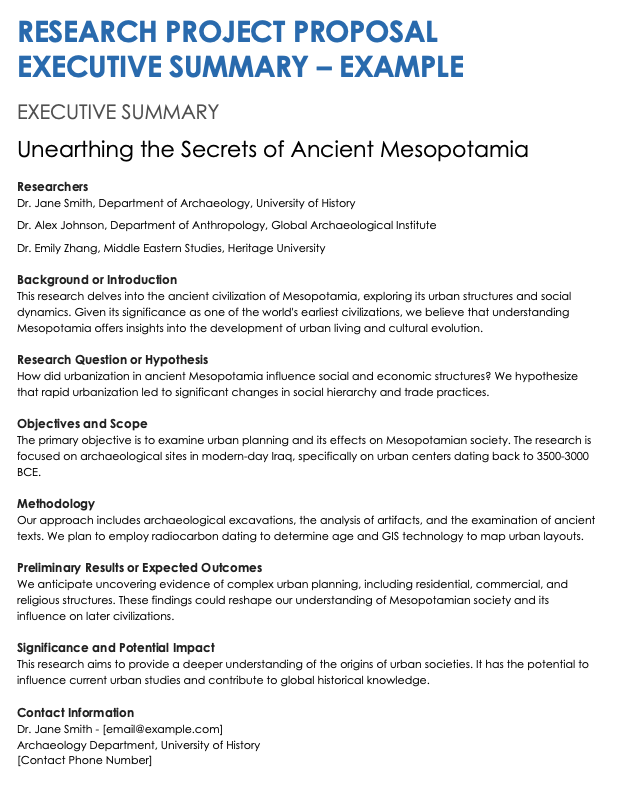
Download a Blank Research Project Proposal Executive Summary Template for Microsoft Word | Google Docs
Download an Example Research Project Proposal Executive Template for Microsoft Word | Google Docs
Teams can use this one-page executive summary — available in a blank or sample version — to concisely present the key elements of a research project to stakeholders, potential funders, or academic committees. By structuring the summary with specific sections such as background, objectives, and methodology, you can be sure that you’ve clearly and briefly outlined all critical aspects of your research.
Executive Summary Slide Example
Executive summaries are often documents that one distributes to executives, potential investors, and other stakeholders. However, slideshow presentations can facilitate a more interactive discussion. Plus, the inclusion of charts, graphs, and other images can better illustrate key points.
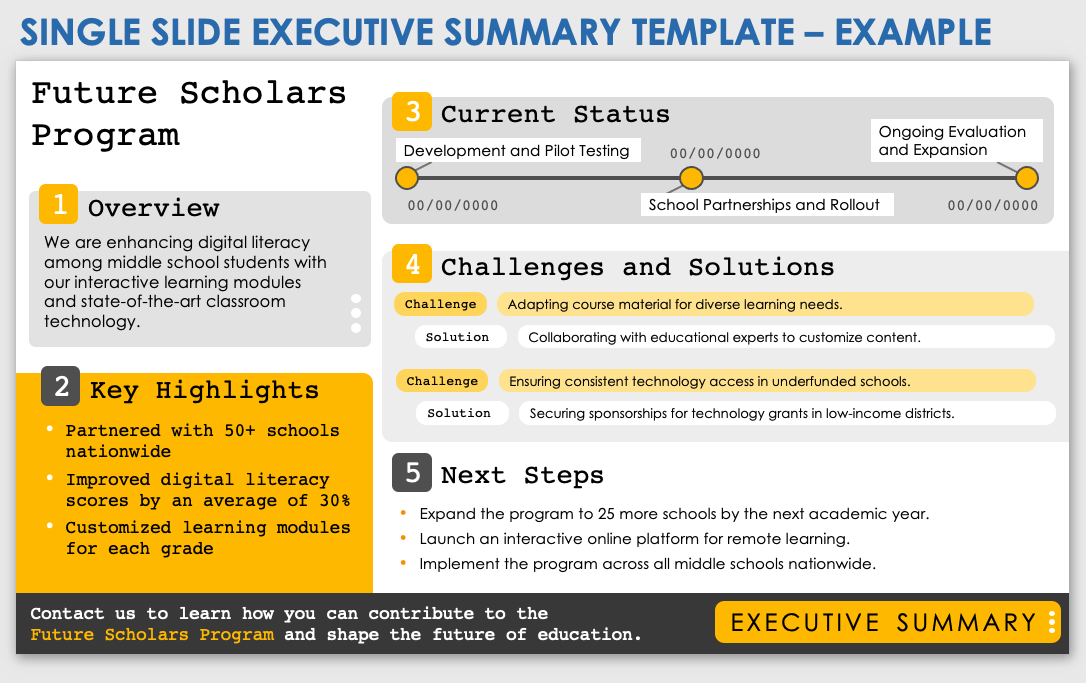
Download an Example Single Slide Executive Summary Template for
PowerPoint | Google Slides
Download a Blank Single Slide Executive Summary Template for
This executive summary slide template is a versatile tool for succinctly conveying key project information in a single, visually engaging slide. You can enter your project information in the blank template or download the sample version for additional guidance. Input relevant details in each section, such as an overview of your project and next steps. The template allows users to insert their own text, graphics, and data. Copy your completed slide into a longer presentation, or use it on its own as a visual complement to any stakeholder presentation.
How to Improve Your Executive Summary
A poorly constructed executive summary can serve as an instructive example of what to avoid. Ineffective executive summaries might be too detailed or technical, lack focus on key points, or omit a clear call to action.
Here are examples of the three most common mistakes found in executive summaries:
Includes Too Many Details or Technical Information
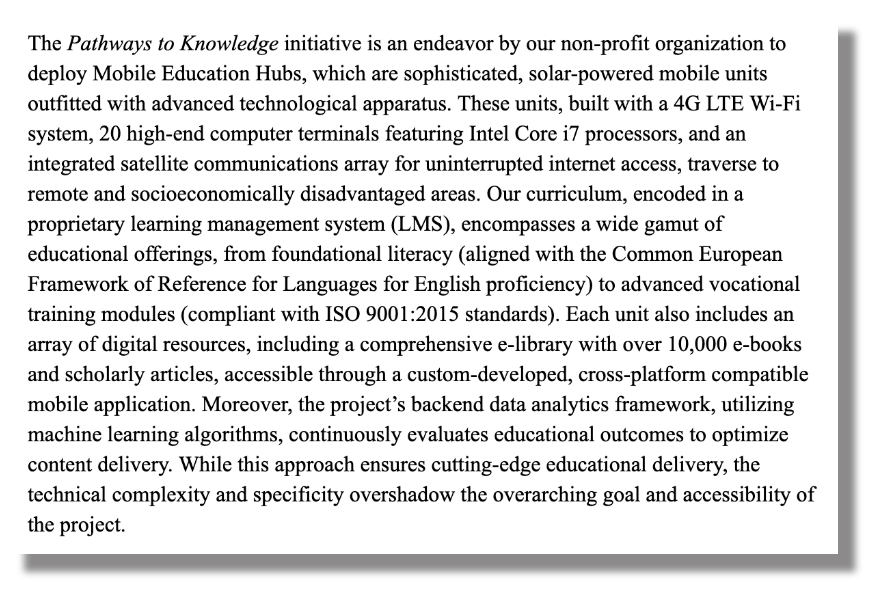
This example demonstrates one of the most common mistakes, which is including too much detail or overly technical language. It dives deeply into the specific technical specifications of the equipment and financial metrics, which might be overwhelming for readers. A more effective executive summary would focus on the broader objectives, expected impacts, and benefits of the project in a language that is accessible to a non-technical audience.
Lacks Focus on Key Points
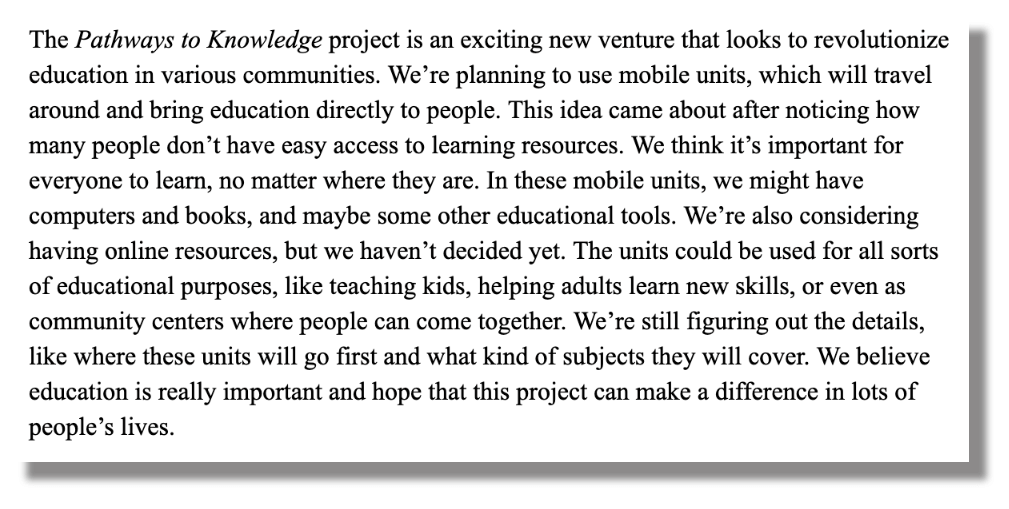
Sometimes, summaries fail to clearly highlight the most critical aspects of the project or proposal. This summary lacks focus concerning the key points of the Pathways to Knowledge project. A more effective summary would concisely state the project’s goal, significance, and anticipated outcomes.
Omits a Clear Call to Action or Conclusion
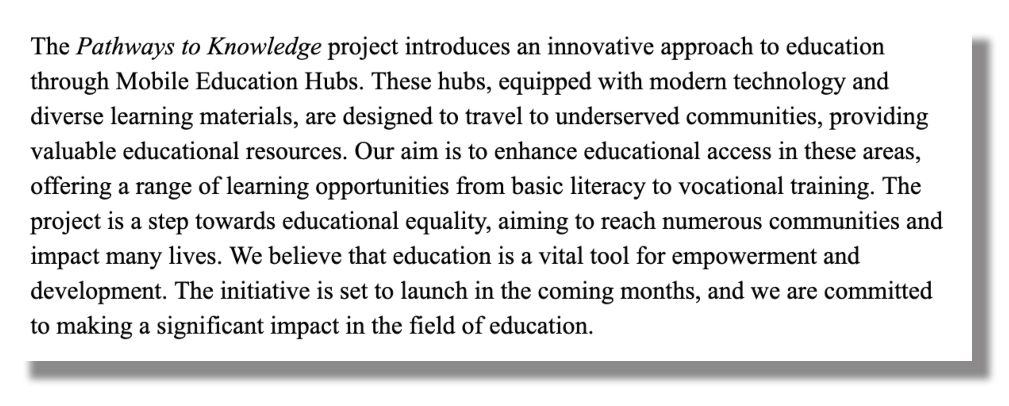
Failing to include a clear conclusion or call to action is another common mistake. The summary should not only inform but also persuade and guide the reader toward the desired action or decision. This summary outlines the project’s goals and structure, but omits a clear call to action. The document doesn’t specify what is expected from the reader or potential stakeholders, such as support, partnership, funding, or involvement in the project.
Corrected Example
To create a more effective example, start by removing overly technical details. (Stakeholders don’t need to know the specific standards with which the training modules are aligned or which types of processors power your computers.) Next, take out unnecessary details that stray from the main point of the project. An executive summary is not the place to discuss the origins of the project idea or the elements your team has not yet decided on. Finally, always conclude your executive summary with a clear call to action.
The Pathways to Knowledge project is a pioneering educational initiative by a nonprofit organization, aimed at bridging the educational divide in underprivileged and remote communities. This project involves the deployment of Mobile Education Hubs: state-of-the-art, solar-powered mobile units that are equipped with educational resources, technology, and internet access. These hubs are designed to travel to various underserved areas, providing children and adults with access to quality educational materials, online learning platforms, and virtual tutoring. Each hub also hosts workshops and seminars led by educators and experts, covering a wide range of subjects from basic literacy and numeracy to vocational training and digital literacy. The initiative seeks to empower communities by enhancing educational opportunities, fostering a culture of lifelong learning, and equipping individuals with the skills necessary for the 21st-century job market. By focusing on accessibility and adaptability, the Pathways to Knowledge project aspires to create a ripple effect of educational advancement and social upliftment across diverse communities.
Master the Art of Writing Executive Summaries with Examples for Business Plans, Project Plans, and Research Projects from Smartsheet
Empower your people to go above and beyond with a flexible platform designed to match the needs of your team — and adapt as those needs change.
The Smartsheet platform makes it easy to plan, capture, manage, and report on work from anywhere, helping your team be more effective and get more done. Report on key metrics and get real-time visibility into work as it happens with roll-up reports, dashboards, and automated workflows built to keep your team connected and informed.
When teams have clarity into the work getting done, there’s no telling how much more they can accomplish in the same amount of time. Try Smartsheet for free, today.
Discover why over 90% of Fortune 100 companies trust Smartsheet to get work done.
- Search Search Please fill out this field.
- Building Your Business
- Becoming an Owner
- Business Plans
How to Write an Executive Summary
Make Writing Your Executive Summary Easier With This Example
Susan Ward wrote about small businesses for The Balance for 18 years. She has run an IT consulting firm and designed and presented courses on how to promote small businesses.
:max_bytes(150000):strip_icc():format(webp)/SusanWardLaptop2crop1-57aa62eb5f9b58974a12bac9.jpg)
What to Include in an Executive Summary
Executive summary example.
The Balance / Jo Zhou
An executive summary is a brief overview at the beginning of your business plan. It should provide a short, concise summary of your business that captures the reader's attention and gives them an interest in learning more about it.
The executive summary is important as it sets the tone for the entire business plan and can often be the deciding factor in whether the reader continues. See an example of a business plan's executive summary and learn the key components of one so you can begin writing one of your own.
The executive summary goes near the beginning of the business plan but is written last. To include a summary of the different parts of your business plan, you'll need to write them first.
When you write the executive summary, keep it under two pages. The executive summary should contain brief summaries of other sections of the plan.
The idea is to give a brief overview of your business first before going into detail about each of the different parts.
The executive summary should contain all of the important information about your business, such as:
- Business name
- Business location
- Your mission as a company
- A history of the company
- Management and advisors
- Services or products offered
- The market for your offerings
- Your business's competitive advantages
- Your financial projections
- Startup financing required, if any
Format the executive summary clearly and attractively, with headings for each section. Your word processing software may have a template you can use that will make your business plan look good.
It's always easier to write something if you can read an example first, so here's an executive summary example that you can use as a model for your own business plan's executive summary.
This executive summary is for a fictional company called Pet Grandma Inc.
Company Mission
Pet Grandma Inc. offers superior on-site pet sitting and exercising services for dogs and cats, providing the personal loving pet care that the owners themselves would provide if they were home. Our team will ensure that pet owners can take business trips or vacations knowing that their pets are in good hands.
Company and Management
Pet Grandma Inc. is headquartered in the City of West Vancouver and incorporated in the Province of British Columbia. The company is owned by partners Pat Simpson and Terry Estelle. Pat has extensive experience in animal care while Terry has worked in sales and marketing for 15 years.
The management of Pet Grandma Inc. consists of co-owners Pat Simpson and Terry Estelle. Both partners will be taking hands-on management roles in the company. In addition, we have assembled a board of advisors to provide management expertise. The advisors are:
- Juliette LeCroix, partner at LeCroix Accounting LLP
- Carey Boniface, veterinarian and partner at Little Tree Animal Care Clinic
- John Toms, president of Toms Communications Ltd.
Our clients are dog owners and cat owners who choose to leave their pets at home when they travel, or who want their pets to have company when their owners are at work. Pet Grandma Inc. offers a variety of pet care services, all in the pet’s home environment, including:
- Dog walking
- Daily visits
- 24-hour care for days or weeks
- Administration of medications by qualified staff
- Emergency treatment in case of illness (arranged through veterinarians)
- Plant watering
- Mail collection
- Garbage/recycling
Across Canada, the pet care industry has seen an explosion of growth over the last three years. West Vancouver is an affluent area with a high pet density. Our market research has shown that nine out of 10 pet owners polled in West Vancouver would prefer to have their pets cared for in their own homes when they travel rather than be kenneled and six out of 10 would consider having a pet sitter provide company for their dog when they were at work.
Competitive Advantages
While there are currently eight businesses offering pet sitting in West Vancouver, only three of these offer on-site pet care and none offers “pet visit” services for working pet owners.
Pet Grandma’s marketing strategy is to emphasize the quality of pet care we provide (“a Grandma for your pet!”) and the availability of our services. Dog owners who work, for instance, will come home to find happy, friendly companions who have already been exercised and walked, instead of demanding, whiny animals.
All pet services will be provided by animal care-certified staff.
All employees are insured and bonded.
Financial Projections
Based on the size of our market and our defined market area, our sales projections for the first year are $340,000. We project a growth rate of 10% per year for the first three years.
The salary for each of the co-owners will be $40,000. At startup, we will have six trained staff to provide pet services and expect to hire four more this year once financing is secured. To begin with, co-owner Pat Simpson will be scheduling appointments and coordinating services, but we plan to hire a full-time receptionist this year as well.
Already we have service commitments from more than 40 clients and plan to aggressively build our client base through newspaper, website, social media, and direct mail advertising. The loving, on-site professional care that Pet Grandma Inc. will provide is sure to appeal to cat and dog owners throughout the West Vancouver area.
Startup Financing Requirements
We are seeking an operating line of $150,000 to finance our first-year growth. Together, the co-owners have invested $62,000 to meet working capital requirements.
Key Takeaways
- An executive summary is a concise overview of the business plan.
- Place the executive summary near the beginning of the business plan.
- Before you write the executive summary, you'll have to write the rest of the business plan first.
- The executive summary should contain all relevant information about the business, including name, mission, services offered, market, and financial projections.

How To Write an Executive Summary for a Business Plan + Example
Written by Dave Lavinsky

Executive Summary of a Business Plan
The Executive Summary is the most important part of your entire business plan . This is because it’s the first section in your plan, and if it doesn’t excite readers, they won’t continue reviewing it. Importantly, there is a way to ensure your executive summary is compelling and includes the key information readers expect. In this article, you’ll learn how to craft the perfect executive summary for your business plan.
Download our Ultimate Business Plan Template here >
Table of Contents:
What is an Executive Summary?
Why do i need an executive summary.
- How Long Should an Executive Summary Be for a Business Plan?
How To Write an Executive Summary for a Business Plan + Template
- Sample Executive Summary
An executive summary of a business plan gives readers a high-level overview of your business plan and highlights its key points.
The executive summary should start with a brief overview of your business concept. Then it should briefly summarize each of the key elements of your business plan: your industry analysis , customer analysis , competitive analysis , marketing plan , operations plan , management team , financial plan and funding needs.
If presented for funding, the executive summary provides the lender or investor a quick snapshot which helps them determine their interest level and if they should continue reading the rest of the business plan.
An effective executive summary is a quick version of your complete business plan. You need to keep it simple and succinct in order to grab the reader’s attention and convince them it’s in their best interest to keep reading.
As mentioned above, your business plan is a detailed document that requires time to read. Capture the attention of your intended audience with a concise format that provides an compelling overview of your plan to save them time and indicate which parts of the business plan may be most important to read in detail. This increases the odds that your business plan will be read and your business idea understood. This is why you need a well-written executive summary.
How Long Should a Business Plan Executive Summary Be?
When structuring your business plan executive summary, the first thing to keep in mind is that it should be short and comprehensive. The length of your executive summary should never exceed 3 pages; the ideal length is one or two pages.
Finish Your Business Plan Today!
To write a compelling executive summary, follow the steps below and use this free executive summary template as a guide:
1. State the Problem and/or Business Opportunity
Generally there is a gap or a problem in the market which your business aims to solve. This is your problem statement and it must be included in the summary, as potential investors want to understand if the world truly needs your company’s products and/or services.
2. Briefly Describe Your Business Idea
The next thing a reader would want to know is how you plan to approach the problem and solve it. This is your business model and it should briefly describe how your product or service can help solve the problem.
3. Provide Key Information About Your Company History
The best indicator of future success is past success. Your company’s history helps the reader understand how your business has evolved and grown over the years and what you’ve been able to accomplish. Even startups have generally accomplished milestones like choosing a business name, conceiving products, finding a location, etc.
4. Conduct Market Research About Your Industry
Conducting thorough market research will help you detail the industry in which you are operating, it’s size and if any trends are positively or negatively influencing it. This gives readers a sense of the size of the opportunity you are pursuing.
5. Identify the Target Market or Ideal Customer
Every business has a target customer base or a target market on which they focus. Here you will detail your target customers including their demographic and psychographic profiles.
6. Explain Your Competitive Advantage
When you venture into a market or an industry, there are generally other players with which you compete. Knowing your competition is crucial to your success. Readers of your plan want to know who your competitors are, their strengths and in what areas you will have competitive advantage. Discussing the competitive landscape is a crucial component of a strong executive summary.
7. Establish Relevant Milestones For Your Business To Achieve
In addition to showing relevant milestones your company has achieved, you need to explain your timeline for milestones or essential points in the future. Include dates you hope to launch products, achieve sales milestones, hire key employees, etc.
8. Develop a Financial Plan
If you are requesting funding from investors or banks, they will want to know how you are going to their funds. Include key financial information regarding how and where you plan to allocate the funds should be included in the summary. For existing businesses, you should also provide a history/summary of past financial performance. Finally, for all businesses, you need to provide future financial projections so investors can determine whether they might get an adequate return from investing in you and lenders can ascertain whether or not you will be able to repay your debts.
9. Describe the Qualifications of Your Management Team
In this section, you will introduce the key members of your team. The success or failure of your company depends largely on the parties involved. So, any reader surely wants to know how well equipped your team is. Mention key staff members and the experience and skills they bring, in the executive summary.
Whether you’re a large or small business, your executive summary is the first thing someone reads that forms an opinion of your business. Whether they decide to read your detailed business plan or push it aside depends on how good your executive summary is. We hope this guide helps you craft an effective and impactful executive summary. That way, readers will be more likely to read your full plan, request an in-person meeting, and give you funding to pursue your business plans.

Finish Your Business Plan in 1 Day!
Don’t you wish there was a faster, easier way to finish your business plan?
With Growthink’s Ultimate Business Plan Template you can finish your plan in just 8 hours or less!
Looking to get started on your business plan’s executive summary? Take a look at the great executive summary example below.
Business Plan Executive Summary Example
Shoutmouth.com executive summary, business overview.
Launched late last year, Shoutmouth.com is the most comprehensive music news website on the Internet.
Music is one of the most searched and accessed interests on the Internet. Top music artists like Taylor Swift receive over 5 million searches each month. In addition, over 500 music artists each receive over 25,000 searches a month.
However, music fans are largely unsatisfied when it comes to the news and information they seek on the artists they love. This is because most music websites (e.g., RollingStone.com, MTV.com, Billboard.com, etc.) cover only the top eight to ten music stories each day – the stories with mass appeal. This type of generic coverage does not satisfy the needs of serious music fans. Music fans generally listen to many different artists and genres of music. By publishing over 100 music stories each day, Shoutmouth enables these fans to read news on all their favorite artists.
In addition to publishing comprehensive music news on over 1200 music artists, Shoutmouth is a social network that allows fans to meet and effectively communicate with other fans about music, and allows them to:
- Create personal profiles
- Interact with other members
- Provide comments on news stories and music videos
- Submit news stories and videos
- Recommend new music artists to add to the community
- Receive customized news and email alerts on their favorite artists
Success Factors
Shoutmouth is uniquely qualified to succeed due to the following reasons:
- Entrepreneurial track record : Shoutmouth’s CEO and team have helped launch numerous successful ventures.
- Monetization track record : Over the past two years, Shoutmouth’s founders have run one of the most successful online affiliate marketing programs, having sold products to over 500,000 music customers online.
- Key milestones completed : Shoutmouth’s founders have invested $500,000 to-date to staff the company (we currently have an 11-person full-time team), build the core technology, and launch the site. We have succeeded in gaining initial customer traction with 50,000 unique visitors in March, 100,000 unique visitors in April, and 200,000 unique visitors in May.
Unique Investment Metrics
The Shoutmouth investment opportunity is very exciting due to the metrics of the business.
To begin, over the past five years, over twenty social networks have been acquired. The value in these networks is their relationships with large numbers of customers, which allow acquirers to effectively sell to this target audience.
The sales price of these social networks has ranged from $25 to $137 per member. Shoutmouth has the ability to enroll members at less than $1 each, thus providing an extraordinary return on marketing expenditures. In fact, during a recent test, we were able to sign-up 2,000 members to artist-specific Shoutmouth newsletters at a cost of only 43 cents per member.
While we are building Shoutmouth to last, potential acquirers include many types of companies that seek relationships with music fans such as music media/publishing (e.g., MTV, Rolling Stone), ticketing (e.g., Ticketmaster, LiveNation) and digital music sales firms (e.g., iTunes).
Financial Strategy, Needs and Exit Strategy
While Shoutmouth’s technological, marketing and operational infrastructure has been developed, we currently require $3 million to execute on our marketing and technology plan over the next 24 months until we hit profitability.
Shoutmouth will primarily generate revenues from selling advertising space. As technologies evolve that allow us to seamlessly integrate music sampling and purchasing on our site, sales of downloadable music are also expected to become a significant revenue source. To a lesser extent, we may sell other music-related items such as ringtones, concert tickets, and apparel.
Topline projections over the next three years are as follows:
Download our executive summary example business plan PDF .
By writing an executive summary that highlights your business’s potential and key strengths, you can entice your target audience to delve deeper into your full business plan. Remember, this is your chance to make a strong first impression and convince them your idea is worth their investment. Take the time to refine your summary, ensuring it’s concise and informative, and leaves the reader wanting more. With a well-written executive summary, you’ll be well on your way to securing the funding or support you need to turn your business dream into a reality.

🎧 Real entrepreneurs. Real stories.
Subscribe to The Hurdle podcast today!
How to Write an Executive Summary

9 min. read
Updated December 13, 2023

An executive summary isn’t just the beginning of your business plan – it’s your opening act, your first chance to impress potential investors, banks, clients and other stakeholders.
An effective executive summary gives decision-makers critical information about your business instantly.
Creating an executive summary is more than just a writing exercise. It requires careful crafting and strategic thinking, as well as an ability to balance the needs to be both succinct and comprehensive.

- What is an executive summary?
The executive summary is a brief introduction and summary of your business plan. It introduces your business, the problem you solve, and what you’re asking from your readers. Anyone should be able to understand your business by simply reading this section of your plan.
While structurally it is the first chapter of your plan—you should write it last. Once you know the details of your business inside and out, you will be better prepared to write this section.
- Why write an executive summary?
The business plan executive summary provides quick access to critical information from your more detailed business plan.
It is essential for informing anyone outside of your business. Many people—including investors and bankers—will only read your summary. Others will use it to decide if they should read the rest. For you, it is a snapshot of your business to reference when planning or revising your strategy.
Now if you’re writing a business plan solely for internal use you may not need an executive summary. However, some internal plans may necessitate writing an executive summary for assignment—such as for an annual operations plan or a strategic plan .
It takes some effort to do a good summary, so if you don’t have a business use in mind, don’t do it.
- How long should it be?
Business plan executive summaries should be as short as possible. Your audience has limited time and attention and they want to quickly get the details of your business plan.
Try to keep your executive summary under two pages if possible, although it can be longer if absolutely necessary. If you have a one-page business plan, you can even use that as your executive summary.
Brought to you by
Create a professional business plan
Using ai and step-by-step instructions.
Secure funding
Validate ideas
Build a strategy
- Executive summary outline
Two pages isn’t a ton of space to capture the full scope of your vision for the business. That means every sentence of your executive summary counts.
You will want to immediately capture the reader’s attention with a compelling introduction. Without getting too lengthy, present who you are as an organization, the problem you are seeking to solve, your skills, and why you are the best entity to solve the problem you’ve outlined.
It’s crucial to establish the need or problem your business is solving in a clear manner, in order to convince your audience that it must be addressed. Following that, recommend the solution and show its value. Be clear and firm in your recommendation, making sure to justify your cause and highlighting key reasons why your organization is the perfect fit for the solution you’re proposing. Finally, a strong conclusion is needed to reiterate the main points and wrap up the executive summary.
What to include in your executive summary
1. business overview.
A one-sentence description that explains what you do, why you do it, and how you do it.
Summarize the problem you’re solving in the market and reference any data that solidifies that there is a need.
3. Solution
Describe your product or service and how it addresses the problem you identified.
4. Target market
Who is your ideal customer? Describe who they are, how they’ll benefit, and why they’re an attainable customer base.
5. Competition
Who are your competitors? List out any primary competition as well as alternatives that your customers may consider. Include key details about their current offerings, promotions, and business strategy.
6. Your team
In your executive summary, outline your organizational structure and current team. List out brief explanations of who you and your team are, your qualifications, and what your function will be within the business. It may be valuable to also highlight any gaps in your team and how you intend to fill them. If you have potential partners or candidates in mind, briefly mention them and expand on their qualifications within your full business plan.
7. Financial summary
Highlight key aspects of your financial plan that address sales, expenses, and profitability. Try to keep these in chart or graph form to ensure the information is easy to consume and resonates visually.
8. Funding requirements
This section is only necessary if you’re seeking out funding or pitching to investors. Be sure to throw out your financing number and reasoning upfront, rather than hiding it later on in your plan. It helps investors understand your position, what you’re asking for, and how you’ll use it.
9. Milestones and traction
Add initial sales, pre-sales, newsletter sign-ups, or anything else that showcases customer interest. Outline what steps you’ve already taken to launch your business, the milestones you’ve hit, and your goals and milestones for the next month, six months, year, etc.
Executive summary vs introduction
A common mistake some people make when starting an executive summary outline is thinking it performs the same function as the introduction to their business plan. In fact, the two serve different purposes and contain different types of information, even though they are both essential.
As we’ve discussed, the executive summary is a high-level overview of the entire business plan. The introduction, by contrast, dives deeper into your business, providing information about the nature of your business, the history of your company, your mission statement, products or services, and the specific problem that your business solves.
The introduction is more detailed, and usually comes right after the executive summary.
On the other hand, the introduction gives investors or lenders – anyone reading your business plan – a sense of why they should continue reading. Think of it more as the space to tell stakeholders why you are speaking to them. An executive summary can also serve this purpose, but the introduction is meant to speak more directly to your target audience, while an executive summary could give a larger audience a general overview of your business.
Tips for writing an effective executive summary
Here are a few best practices to make writing your executive summary easier, and ultimately more effective.
1. Think of an executive summary as your pitch
The executive summary is like an elevator pitch. You’re selling someone on reading your full plan while quickly summarizing the key points. Readers will expect it to cover certain areas of your business—such as the product, market, and financial highlights, at the very least.
While you need to include what’s necessary, you should also highlight areas that you believe will spark the reader’s interest. Remember, you’re telling the brief but convincing story of your business with this summary. Just be sure that you’re able to back it up with the right details with the rest of your business plan.
2. Write it last
Even though the executive summary is at the beginning of a finished business plan, many experienced entrepreneurs choose to write it after everything else. In theory, this makes it easier to write since all of the information is already written out and just needs to be condensed into a shorter format.
Now, if you’ve started with a one-page plan, this process is even easier. Just use your one-page plan as a starting point and add additional details to any sections that need it. You may even find that no changes are necessary.
3. Keep it short
Ideally, the executive summary is short—usually just a page or two, five at the outside—and highlights the points you’ve made elsewhere in your business plan. Whatever length you land on, just focus on being brief and concise. Keep it as short as you can without missing the essentials.
4. Keep it simple
Form follows function, so don’t overcomplicate or over-explain things. The best executive summaries are a mixture of short text, broken up with bullets and subheadings, and illustrations, such as a bar chart showing financial highlights.
Run through a legibility test after writing your summary. Is it easy to skim through? Are the right pieces of information jumping out? If the answer to either of those questions is no, then work back through and try breaking up information or adjusting the formatting.
5. Create an executive summary outline based on importance and strengths
Organize your executive summary outline so that the most important information appears first. While there are specific components to include, there is no set order of appearance. So, use the order to show emphasis.
Lead with what you want to get the most attention, and add the rest by order of importance. For example, you may start with the problem because that can add drama and urgency that tees up the solution you provide.
Additional resources to write a great executive summary
Need more information and guidance to craft a convincing executive summary? Check out these in-depth resources and templates.
Key mistakes to avoid when writing an executive summary
Here are the critical mistakes you should avoid when writing your executive summary.
How to write your executive summary for specific audiences
The executive summary should tell your audience exactly what your business is, what it does, and why it’s worth their time. Here’s how you can take it a step further and fine-tune it for specific people.
How to develop a mission statement
Learn to put a heart behind the business and create an easy-to-understand narrative by writing a mission statement.
Executive Summary FAQ
What is in an executive summary?
The executive summary of a business plan is a brief introduction and summary of your business strategy, operations, and goals.
What is the purpose of an executive summary?
An executive summary is typically written to convince someone to read your more detailed plan. For investors, it may be the only thing they look at when deciding if they’d like to hear your pitch. Loan officers may review it to determine if your business seems financially sound. And partners, mentors, or anyone else may use it to determine if they want to be involved with your business.
How do you start an executive summary?
While there is no required order for an executive summary, it’s often recommended that you lead with the problem you’re solving or the purpose of your business. This will help frame your intent for the reader, and ideally make them more interested in learning more.
How do you write a good executive summary?
A good executive summary is brief, convincing, and easy to read. Focus on keeping things short and concise, only including necessary information. Be sure to lead and highlight anything that is especially interesting or important about your business. And after writing, spend some time reviewing and reformatting to make your summary as attractive to read as possible.
Tim Berry is the founder and chairman of Palo Alto Software , a co-founder of Borland International, and a recognized expert in business planning. He has an MBA from Stanford and degrees with honors from the University of Oregon and the University of Notre Dame. Today, Tim dedicates most of his time to blogging, teaching and evangelizing for business planning.

Table of Contents
- What to include
- Writing tips
- Additional resources
Related Articles

3 Min. Read
What to Include in Your Business Plan Appendix

6 Min. Read
How to Write Your Business Plan Cover Page + Template

10 Min. Read
How to Set and Use Milestones in Your Business Plan

How to Write a Competitive Analysis for Your Business Plan
The LivePlan Newsletter
Become a smarter, more strategic entrepreneur.
Your first monthly newsetter will be delivered soon..
Unsubscribe anytime. Privacy policy .

The quickest way to turn a business idea into a business plan
Fill-in-the-blanks and automatic financials make it easy.
No thanks, I prefer writing 40-page documents.

Discover the world’s #1 plan building software
ZenBusinessPlans
Home » Business Plans
How to Write a Business Plan Executive Summary [Sample Template]

A good executive summary is the holy grail of good business plan writing. Even though it comes after you have written and thought through every other facet of your business, it is arguably the most important part of the puzzle. As its name implies, the executive summary is a brief overview of your business plan. Call it an introduction to your business and you would be very right.
The executive summary gives time-crunched executives or VCs that high-level overview that will either persuade them to read your plan further or toss it in a trashcan without a second thought. Even though the executive summary is the first thing that the readers of your business plan will go through, you should write it last because it summarizes everything from that start to the end of your business plan.
Also, it is usually the first and probably the most important thing that busy investors consider before deciding if your business plan is worth spending a minute on. Secondly, since it’s a summary, you will only be highlighting the main facets of what you have uncovered over the course of writing your business plan. Below is a list of what your executive summary should include:
Components of a Business Plan Executive Summary
- Business concept (what you do or what you intend to do)
- Business goals and vision (what you want to achieve)
- Product/service description and differentiation (what you offer and what makes it different)
- Target market (who you want to sell to)
- Marketing plan (how you plan to reach your customers)
- Current financial state (what you currently make in revenue—for existing business looking at expansion, or how much you already have on ground—for startups)
- Projected financial state (what you foresee making in revenue)
- The request (how much funds you are asking for)
- The team (who runs your business)
Your business plan executive summary must provide brief information on the following areas of your business;
- The target market : it has to describe the type of customers you will be targeting.
- Business model : it should describe your products or services and what will make them appealing to the target market.
- Marketing and sales strategy : it should touch briefly your plans for marketing your products or services.
- The competition : since competition is a major part of business, so it has to describe how you plan on dealing with the completion and gaining market share. It should equally state your competitive advantage.
- Financial analysis : it should summarize your financial plan
- Owners/Staff : it should describe the owners and the key staff members and the expertise they bring to the venture.
- Implementation plan : it should briefly outline the schedule for taking your business from the planning stage to opening your doors.
- An overview of funding requirements : you need to state the amount of funding you need, and what the money would be used for.
- Growth highlights : it should give any instances of growth and, if possible, illustrate that growth with graphs or charts.
- Future Plans : This doesn’t have to be too detailed, but it should give anyone reading your summary an idea of where your business is heading and how you intend to get there.
Writing a business plan executive summary is not that difficult, you only need to include the summary of the details that were listed above. You executive summary should be arranged this way;
Writing a Business Plan Executive Summary – Sample Template
You can start by describing your company, your mission and vision statements. Include your Business Name and address. If you are lost for words on how to describe your company, think about how you want your employees, customers and the business community to view your company.
This intro paragraph should be attention-getting from the start. It is wise to bring in impressive attributes of your company, but be specific here. Potential investors will want to see real evidence of demonstrated skills and unique abilities. Use this section to highlight company or employee accolades, albeit briefly. Describe the organizational structure and name key employees.
The names and titles of key employees are sufficient; however, include a brief description of executive team members’ responsibilities and duties. Include a list of satellite offices, contact information for each location and how many employees would work in each location.
2. Your business offering
Write a description of what your business aims to offer to its target market. Here, you should give a description of the product or service the business expects to offer. Highlight the products or services in a way that sounds appealing and sets you apart from the competition. The aim of the executive summary is to intrigue the reader enough to read what the rest of the business plan holds.
3. Your finances
This section is where you now talk about the financial aspects of your business. Disclose all business partners, investors and banks you have business relationships with. Explain the role of each entity or individual, the amounts invested or financed, and fiduciary terms and responsibilities.
If you are proposing your business plan to additional lending institutions or investors, this information can strengthen your plan by illustrating confidence others have in your ability to operate a successful business. This section should also include sales and profit projections for the business. You are free to use charts or graphs to reflect this information if it would provide more insight than texts.
Construct the final section of your executive summary by drafting comments about your organization’s accomplishments, accolades or remarkable growth. In this section, briefly describe your plan for achieving your company’s future goals.
Having discussed how an executive plan is written, let’s go further by looking at tips on how to ensure that your executive summary is perfectly written.
8 Tips for Writing a Perfect Business Plan Executive Summary
A. you must ensure that your first paragraph is strong enough.
To attract the reader’s attention and compel them to read the rest of the summary. For example, you can start by stating a market problem that your business promises to fix.
b. Remember, it’s all a summary
So, keep it short. The business plan itself will provide the details. So, don’t waste the reader’s time or irritate them by adding unnecessary details in your executive summary.
c. Use strong and positive language
Don’t weaken or dilute your statements with inappropriate words. For example, instead of writing “Our business might just become the market winner in the next five years”, write “Our business is poised to become the market winner in the next five years.”
d. Although there is no standard page length for executive summaries
It is better to keep it within two pages. Always resist the temptation to stuff your business plan’s executive summary with details that are already covered in the rest of the plan. Remember, the summary is meant to present facts about your business and entice the reader to read the rest of the plan.
e. Fine-tune your executive summary after writing it
Read it aloud to yourself. Does it sound great to you? Does it sound clear and brief, but detailed ? If you are satisfied with it, let someone else who knows nothing about your business read it and give suggestions on how you can improve it.
f. Customize the executive summary for your target audience
If your motive is to entice investors, for instance, your summary should hammer on the benefits that investors stand to gain from the opportunity you are presenting to them. Also, use formal or informal language depending on what’s more appropriate for your target audience.
g. Read the executive summary aloud once again
Putting yourself in place of the reader this time. Does the summary trigger your interest in the business or put you off instantly? Does the summary sound too good to be true, due to the choice of words? After reading it thoroughly, make necessary adjustments.
h. Clear your vocabularies of any self-glorifying superlatives
Clichés, and overused expressions that you may not be able to back up. Avoid words like “ best ”, “ ground-breaking ”, “ cutting-edge ”, “ world class ”, etc. Investors and other readers see those words almost every day and they tend to overlook their real meanings.
In conclusion
When writing your executive summary, even though it comes first, but aim to write it last after you have written the rest of your plan. This is the only way to know what exactly you should include when writing it. You have already done the research, so use that when pulling together the salient points of the executive summary.
Also, ensure that you check, double-check and triple-check your executive summary for any errors. Grammatical and spelling errors should be eradicated. But more importantly, your financial projections should contain absolutely no errors. Just one slight financial error will make you an amateur to any savvy investor.
Again, don’t be afraid to let your passion or excitement for your business come through in your executive summary. Investors typically believe that it takes a certain kind of entrepreneur to make a successful business, so capitalize on your commitment to get the backing you need.
More on Business Plans

IMAGES
VIDEO
COMMENTS
Creating an executive summary for your business plan that is comprehensive and concise will help outline your company’s objectives. Get started here.
A business plan executive summary is a condensed overview of the key elements of your business plan. It introduces your business, what you offer (products or services), your target market, and what sets you apart from the competition.
Available in blank and example versions, this executive summary template guides you in succinctly presenting key information about your business plan or project to stakeholders. Simply fill in each section with relevant details to create a concise overview that highlights problems, solutions, market potential, product features, financials, and ...
See an example of a business plan's executive summary and learn the key components of one so you can begin writing one of your own. The executive summary goes near the beginning of the business plan but is written last.
An executive summary is a broad overview of a business document that tells the reader everything they need to know about a business plan or investment proposal. While the length and scope will often depend on the document being summarized, most executive summaries are about one to two pages long.
An executive summary of a business plan gives readers an overview of your business plan and highlights its key points. The executive summary should start with a brief overview of your business concept.
In the executive summary of your business plan, include an overview of what your company does and why it does it. Discuss your mission and values and how they connect to your business plan. Drilling into these emotional elements sets the tone for your proposition and gets people more invested.
An executive summary isn’t just the beginning of your business plan – it’s your opening act, your first chance to impress potential investors, banks, clients and other stakeholders. An effective executive summary gives decision-makers critical information about your business instantly.
An executive summary is a concise and compelling overview of a business plan (or simply a report), designed to provide readers, such as investors, partners, or upper management, with a quick and clear understanding of the document’s most critical aspects.
Are you currently writing a business plan? If YES, here's an in-depth guide and sample template on how to write a workable business plan executive summary